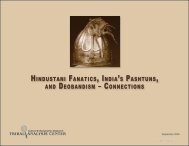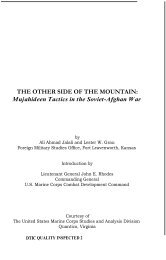the baluch and the brahui and their rebellions - Tribal Analysis Center
the baluch and the brahui and their rebellions - Tribal Analysis Center
the baluch and the brahui and their rebellions - Tribal Analysis Center
You also want an ePaper? Increase the reach of your titles
YUMPU automatically turns print PDFs into web optimized ePapers that Google loves.
The Baluch <strong>and</strong> <strong>the</strong> Brahui - <strong>and</strong> <strong>the</strong>ir RebellionsBugti (aka Bughti): An eastern Baluch tribe located almost exclusively in Dera Bugti District of Sibi Division, Baluchistan. A few also live inSibi District of Sibi Division <strong>and</strong> Barkhan District of Zhob Division. The Bugtis, along with <strong>the</strong> Marris, Dombkis, <strong>and</strong> Jakranis, are known as <strong>the</strong>“hill tribes” <strong>and</strong> have historically been more independent <strong>and</strong> warlike than <strong>the</strong> rest of <strong>the</strong> Baluch. In <strong>the</strong> past <strong>the</strong>y raided <strong>the</strong>ir neighbors, includingthose in Sindh <strong>and</strong> Punjab Provinces, <strong>and</strong> were <strong>the</strong> most troublesome Baluch tribes for <strong>the</strong> British. Today <strong>the</strong> Marri <strong>and</strong> Bugti tribes lead <strong>the</strong> Baluchnationalist movement, along with <strong>the</strong> Mengal Brahuis. As of 1951, <strong>the</strong>re were approximately 31,000 Bugtis.Buledi (aka Boledi, Bolidi, Buledhi, Bulethi, Burdi): Originally located near <strong>the</strong> coasts of Iran <strong>and</strong> Pakistan, <strong>the</strong> Buledi moved north <strong>and</strong> east intoKalat Division, Baluchistan <strong>and</strong> nor<strong>the</strong>rn Sindh, near <strong>the</strong> Indus River, having been pushed out of Mekran by <strong>the</strong> Gichki tribe. Some likely remainedin Sistan va Baluchestan Province, Iran <strong>and</strong> Mekran Division, Baluchistan. Most sources list <strong>the</strong> Buledi as belonging to <strong>the</strong> eastern Baluch, but somelist <strong>the</strong>m as western. One source lists <strong>the</strong>m as a Rind clan. As of 1951, <strong>the</strong>re were approximately 12,500 Buledis.Buzdar (aka Bozdar): Located in Dera Ghazi Khan District, Punjab. The Buzdars are of Rind descent, but have become an independent tribe.Ch<strong>and</strong>ia (aka Ch<strong>and</strong>ya): Located primarily between <strong>the</strong> Indus River in Sindh <strong>and</strong> <strong>the</strong> Baluchistan border where <strong>the</strong>y have reportedly assimilatedwith <strong>the</strong> local inhabitants. They also reside in Dera Ismail Khan District of <strong>the</strong> North-West Frontier Province <strong>and</strong> Muzaffargarh District, Punjab.They may have originally been a Leghari Baluch clan.Dombki (aka Domki, Dumki): An eastern Baluch tribe located primarily in <strong>the</strong> vicinity of Lahri in Bolan District of Nasirabad Division,Baluchistan, but also found in Sindh. The Dombkis are hill tribes, <strong>and</strong> like <strong>the</strong> Marri <strong>and</strong> Bugti, carried out raids against <strong>the</strong>ir neighbors up to <strong>the</strong> late1800s. The Dombki, Marri, Bugti, <strong>and</strong> Jakrani tribes often feuded with <strong>and</strong> raided one ano<strong>the</strong>r, but sometimes allied against o<strong>the</strong>r tribes or <strong>the</strong> British.Dombkis are reputedly <strong>the</strong> storytellers of <strong>the</strong> Baluch <strong>and</strong> <strong>the</strong> recorders of Baluch genealogy. As of 1951, <strong>the</strong>re were approximately 14,000 Dombkis.Drishak: Located primarily in <strong>the</strong> vicinity of Asni in Dera Ghazi Khan District, Punjab. The plains tribes between <strong>the</strong> eastern border ofBaluchistan <strong>and</strong> <strong>the</strong> Indus River in Punjab <strong>and</strong> Sindh, including <strong>the</strong> Drishaks, Gurchanis, Lunds, <strong>and</strong> Mazaris, suffered most from <strong>the</strong> raids conductedby <strong>the</strong> hill tribes, <strong>the</strong> Bugtis, Dombkis, Jakranis, <strong>and</strong> Marris. The plains tribes generally cooperated with <strong>the</strong> British who controlled Punjab <strong>and</strong> Sindhfrom <strong>the</strong> mid-1800s to mid-1900s.Gichki (aka Ghichki): A western Baluch tribe located primarily in Panjgur District of Mekran Division, Baluchistan. The Gichkis are notethnically Baluch, likely originating in Sindh or India as Sikhs or Rajputs, but now speak Baluchi <strong>and</strong> have become assimilated into <strong>the</strong> Baluch. TheGichki likely also absorbed a number of smaller Baluch tribes in <strong>the</strong> Mekran region. The Gichki reportedly entered Mekran around <strong>the</strong> end of <strong>the</strong> 17 thcentury <strong>and</strong>, though a small tribe, by inter-marrying <strong>and</strong> using o<strong>the</strong>r tribal militias, soon became a powerful tribe in <strong>the</strong> area. In <strong>the</strong> late 1700s, <strong>the</strong>Brahui Khan of Kalat seized control of <strong>the</strong> Mekran region, but allowed <strong>the</strong> Gichki chiefs to manage it as a state within <strong>the</strong> Khanate. In <strong>the</strong> late 1800s,<strong>the</strong> Nausherwanis, who had entered western Baluchistan from Iran <strong>and</strong> settled in Kharan District of Kalat Division, exp<strong>and</strong>ed into Mekran, reducingGichki power until <strong>the</strong> British checked <strong>the</strong>ir advances. As of 1951, <strong>the</strong>re were approximately 3,500 Gichkis.Gurchani (aka Garshani, Gorchani, Gurcshani): Located in <strong>the</strong> vicinity of Lalgarh, near Harr<strong>and</strong> in Dera Ghazi Khan District, Punjab. They arereportedly originally descended from <strong>the</strong> Dodai, a once important tribe that no longer exists. The Gurchani tribe has over time absorbed elements of<strong>the</strong> Buledi, Lashari, <strong>and</strong> Rind Baluch. The plains tribes between <strong>the</strong> eastern border of Baluchistan <strong>and</strong> <strong>the</strong> Indus River in Punjab <strong>and</strong> Sindh, including<strong>the</strong> Drishaks, Gurchanis, Lunds, <strong>and</strong> Mazaris, suffered most from <strong>the</strong> raids conducted by <strong>the</strong> hill tribes, <strong>the</strong> Bugtis, Dombkis, Jakranis, <strong>and</strong> Marris.The plains tribes generally cooperated with <strong>the</strong> British who controlled Punjab <strong>and</strong> Sindh from <strong>the</strong> mid-1800s to mid-1900s.<strong>Tribal</strong> <strong>Analysis</strong> <strong>Center</strong>, 6610-M Mooretown Road, Box 159. Williamsburg, VA, 23188
















